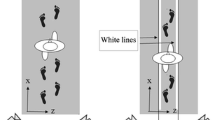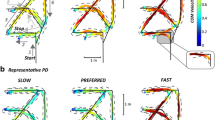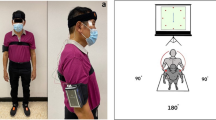Abstract
Turning while walking is a common but demanding task requiring modification of the motor program from linear walking to lateral turning and it is associated with a high risk of falls. Patients with cerebellar ataxia have unstable gait and report a high incidence of falls. In the present study, we investigated the motor strategies adopted by ataxic patients when performing turns of different degrees and directions of rotation. Ten ataxic patients and 10 controls were analyzed while performing 30°/90° turns to the right/left. We recorded the number of completed turn tasks, the number of steps needed, and the time taken to complete the task, time–distance parameters and the onset of head, trunk and pelvis reorientation. The ataxic patients were less able to complete 90° turns, displayed a greater stride width, shorter step length, and greater number of steps when turning, and were unable to flexibly adjust their stride width across the turning task. The duration of the turning task and of the segmental reorientation did not differ from control values. Our findings indicate that ataxic patients have more difficulties in performing large turns and adopt a series of compensatory strategy aimed at reducing the instability associated with turning, such as enlarge the base of support, shorten the step length, increase the number of steps, and use the “multi-step” rather than the “spin-turn” strategy. Given the high risk of falls related to this task, it would be useful to include turning training in the rehabilitation protocol of ataxic patients.





Similar content being viewed by others
References
Akram SB, Frank JS, Fraser J (2010) Effect of walking velocity on segment coordination during pre-planned turns in healthy older adults. Gait Posture 32(2):211–214
Barak Y, Wagenaar RC, Holt KG (2006) Gait characteristics of elderly people with a history of falls: a dynamic approach. Phys Ther 86(11):1501–1510
Bender R, Lange S (2001) Adjusting for multiple testing—when and how? J Clin Epidemiol 54(4):343–349
Crenna P, Carpinella I, Rabuffetti M, Calabrese E, Mazzoleni P, Nemni R, Ferrarin M (2007) The association between impaired turning and normal straight walking in Parkinson’s disease. Gait Posture 26(2):172–178
Cumming RG, Klineberg RJ (1994) Fall frequency and characteristics and the risk of hip fractures. J Am Geriatr Soc 42(7):774–778
Davis RB, Ounpuu S, Tyburski D, Gage JR (1991) A gait analysis data collection and reduction technique. Hum Mov Sci 10:575–587
Glaister BC, Bernatz GC, Klute GK, Orendurff MS (2007) Video task analysis of turning during activities of daily living. Gait Posture 25(2):289–294
Gutierrez-Farewik EM, Bartonek A, Saraste H (2006) Comparison and evaluation of two common methods to measure center of mass displacement in three dimensions during gait. Hum Mov Sci 25(2):238–256
Huxham F, Gong J, Baker R, Morris M, Iansek R (2006) Defining spatial parameters for non-linear walking. Gait Posture 23(2):159–163
Huxham F, Baker R, Morris ME, Iansek R (2008) Footstep adjustments used to turn during walking in Parkinson’s disease. Mov Disord 23(6):817–823
Lam T, Luttmann K (2009) Turning capacity in ambulatory individuals poststroke. Am J Phys Med Rehabil 88(11):873–883
Lamontagne A, Fung J (2009) Gaze and postural reorientation in the control of locomotor steering after stroke. Neurorehabil Neural Repair 23(3):256–266
Mak MKY, Patla A, Hui-Chan C (2008) Sudden turn during walking is impaired in people with Parkinson’s disease. Exp Brain Res 190(1):43–51
Morton SM, Bastian AJ (2003) Relative contributions of balance and voluntary leg-coordination deficits to cerebellar gait ataxia. J Neurophysiol 89(4):1844–1856
Morton SM, Bastian AJ (2004) Cerebellar control of balance and locomotion. Neuroscientist 10(3):247–259
Palliyath S, Hallett M, Thomas SL, Lebiedowska MK (1998) Gait in patients with cerebellar ataxia. Mov Disord 13(6):958–964
Paquette MR, Fuller JR, Adkin AL, Vallis LA (2008) Age-related modifications in steering behaviour: effects of base-of-support constraints at the turn point. Exp Brain Res 190(1):1–9
Patla AE, Adkin A, Ballard T (1999) Online steering: coordination and control of body center of mass, head and body reorientation. Exp Brain Res 129(4):629–634
Salman ME (2002) The cerebellum: it’s about time! But timing is not everything—new insights into the role of the cerebellum in timing motor and cognitive tasks. J Child Neurol 17(1):1–9
Segal AD, Orendurff MS, Czerniecki JM, Schoen J, Klute GK (2011) Comparison of transtibial amputee and non-amputee biomechanics during a common turning task. Gait Posture 33(1):41–47
Serrao M, Pierelli F, Ranavolo A, Draicchio F, Conte C, Don R, Di Fabio R, Lerose M, Padua L, Sandrini G, Casali C (2012) Gait pattern in inherited cerebellar ataxias. Cerebellum 11(1):194–211
Stack EL, Ashburn AM, Jupp KE (2006) Strategies used by people with Parkinson’s disease who report difficulty turning. Parkinsonism Relat Disord 12(2):87–92
Stolze H, Klebe S, Petersen G, Raethjen J, Wenzelburger R, Witt K, Deuschl G (2002) Typical features of cerebellar ataxic gait. J Neurol Neurosurg Psychiatr 73(3):310–312
Taylor MJ, Dabnichki P, Strike SC (2005) A three-dimensional biomechanical comparison between turning strategies during the stance phase of walking. Hum Mov Sci 24(4):558–573
Thach WT, Goodkin HP, Keating JG (1992) The cerebellum and the adaptive coordination of movement. Ann Rev Neurosci 15:403–442
Thigpen MT, Light KE, Creel GL, Flynn SM (2000) Turning difficulty characteristics of adults aged 65 years or older. Phys Ther 80(12):1174–1187
Timmann D, Horak FB (2001) Perturbed step initiation in cerebellar subjects: 2. Modification of anticipatory postural adjustments. Exp Brain Res 141(1):110–120
Trouillas P, Takayanagi T, Hallett M et al (1997) International Cooperative Ataxia Rating Scale for pharmacological assessment of the cerebellar syndrome. The Ataxia Neuropharmacology Committee of the World Federation of Neurology. J Neurol Sci 145(2):205–211
van de Warrenburg BP, Steijns JA, Munneke M, Kremer BP, Bloem BR (2005) Falls in degenerative cerebellar ataxias. Mov Disord 20(4):497–500
Winter DA (1979) Biomechanics of human movement. Wiley, New York
Xu D, Carlton LG, Rosengren KS (2004) Anticipatory postural adjustments for altering direction during walking. J Mot Behav 36(3):316–326
Acknowledgments
We thank Mrs. Catherine Wrenn for English revision.
Conflict of interest
Authors declare that they have no conflict of interest.
Author information
Authors and Affiliations
Corresponding author
Additional information
Silvia Mari and Mariano Serrao: Equal contributors.
Rights and permissions
About this article
Cite this article
Mari, S., Serrao, M., Casali, C. et al. Turning strategies in patients with cerebellar ataxia. Exp Brain Res 222, 65–75 (2012). https://doi.org/10.1007/s00221-012-3197-2
Received:
Accepted:
Published:
Issue Date:
DOI: https://doi.org/10.1007/s00221-012-3197-2




